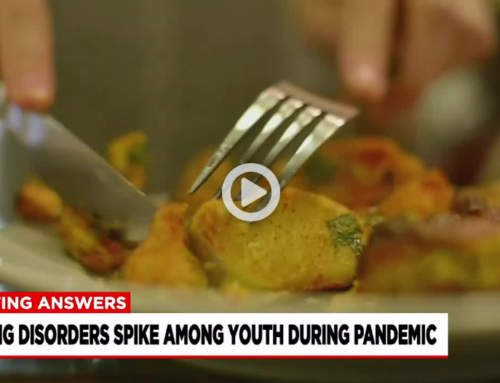Our understanding of eating disorders is constantly evolving. One of the eating disorders the world is less familiar with is known as Avoidant Restrictive Food Intake Disorder (ARFID), and has only recently become a recognized disorder. Often mistaken for “picky eating,” this disorder is very real and can lead to severe malnutrition and medical consequences.
What Is ARFID?
ARFID is characterized by “an eating or feeding disturbance (e.g. apparent lack of interest in eating or food; avoidance based on the sensory characteristics of food; concern about aversive consequences of eating) as manifested by persistent failure to meet appropriate nutritional and/or energy needs” (DSM V). In simpler terms, this means someone with ARFID experiences intense anxiety around specific food tastes or textures, and/or a fear of the physical effect eating it may have on them (e.g. gagging, choking, vomiting, stomach aches). As a result, the person will avoid, or restrict, specific types of foods and/or certain amounts of foods. This behavior is often associated with unintentional weight loss, failure to achieve expected weight gain or height, nutritional deficiency, impact on daily functioning, and even dependence on enteral feeding (i.e. feeding tube) or nutritional supplements. As with other eating disorder presentations, ARFID often results from a thinking error or illogical thought, such as “If I eat that, I am going to gag or choke” or “That food is definitely contaminated.”
ARFID is a unique eating disorder in that the body image distortions (e.g. fear of appearing fat) often experienced by someone who presents with anorexia or bulimia are not usually present. That being said, patients with ARFID may experience poor body image related to being visibly smaller, in height and/or weight, by their same-age peers.
Case Study:
Let’s look at a specific case: John*, a former adolescent patient at Walden’s Intensive Outpatient Program (IOP) in Braintree, MA, presented with an approx. three-year history of ARFID. According to John’s mother, Elizabeth*, the ARFID had a profound effect on not just John, but also on others in the family. “I often felt defeated before dinner even began because his behavior was most predictable,” Elizabeth shares. “His acceptable dinner choices were very narrow accompanied with multiple idiosyncrasies—too hard, too soft, too mushy, too chewy, too crunchy.
[My daughter and I] had broader palettes which led to discord with his sister; she would often want to leave the table because of his chronic complaining. Meals were miserable!”
Initially in IOP, John struggled with portion sizes and frequently complained of being full, fearing stomach pain, and believing he would naturally vomit if eating “too much.” John started treatment with a limited list of foods he was willing to eat. Given that John had a significant food allergy and a recent history of anemia, his mother was fearful that his condition would be near impossible to treat, and his medical state would only worsen. Elizabeth was baffled by how quickly the ARFID had affected John’s health: “He was a robust baby and toddler – top of his growth charts. He ate a wide variety of foods. The ‘perfect storm’ of life events unfolded before my eyes, and his eating disorder became very REAL. He had reached a plateau, then a decline in his growth chart. He was considered malnourished with a BMI below average. I was at a loss because I didn’t understand what was going on, nor could I relate. Accepting he actually had an ED was sobering yet affirming—there was a reason for this strange behavior and relationship with food.”
The first few program nights were certainly challenging. John would become very tearful – and fearful – during family dinners at program. “I can’t do it” was his catchphrase, and this self-doubt only exacerbated his struggle. When reflecting on meals prior to treatment, John says, “I was never pleased … I wanted the same food every night. I would try my hardest to make up excuses about the food. I would cry about it and I couldn’t bring myself to eat. I was trapped in a cycle of non-eating at meals.”
The initial goal was to have John take one more bite than he was comfortable with – a Maudsley Method technique used primarily in the treatment of adolescents who restrict food intake. Early in treatment, John’s mother would serve him a large serving of a type of food he was comfortable with. This way, the portion provided enough substance to weight-restore, which was one of his treatment goals. In addition, John’s mother incorporated “test foods” into his meals – sample size servings of foods that had previously given John anxiety, or foods he had never tried. This sent John the message that she was going to challenge him – but not overwhelm him – with a serving of something his eating disorder told him was horrifying.
Helpful Interventions:
Slowly but surely, John began to complete the larger meals he needed to both weight-restore and facilitate the growth spurt that had been stunted by malnutrition. His mother was able to use the techniques modeled by staff during family dinners at program, and encourage John to “take another bite” at home, which she later cited as “key” for recovery. During his treatment sessions, we implemented a token economy type system, offering John rewards for his progress. Every time John finished dinner in a timely manner (45 minutes, as compared to the hours it had taken him previously), he would receive points towards an overall reward of his choice.
After a few weeks, John was asking for new foods, pushing himself to finish larger portion sizes, and was definitely seeing results. Family tension had calmed during meals, although there were certainly moments when the eating disorder took over – as with other eating disorders, recovery is not linear. John was finishing meals at a reasonable pace. John looked forward to his twice weekly weight-checks at program, and felt a sense of accomplishment when he saw that his weight was increasing. It was as if all his hard work had paid off – he was not only gaining weight (and height!), but also health. John particularly found adolescent groups, such as Dialectical Behavior Therapy (DBT), helpful, sharing, ”I had times where I was in a mood where I was mad or upset, [and] I used skills to make my life better.”
Elizabeth learned a number of helpful approaches throughout treatment. She writes, “Identifying the eating disorder as something [separate from John] took the pressure off him— it did not define him, nor did it make him a bad person. Follow through, follow through, and more follow through – accompanied with a lot of patience – made meals bearable. Much like parenting, consistency and follow through regarding the rules around food/meals was at the core of success.”
Life After Treatment:
John and his mother were able to fight his eating disorder with the help of coached meals, “test foods,” a rewards system, and skills groups. John has maintained his progress since discharge from IOP; Elizabeth writes, “He is more confident and happier overall with himself. He feels a sense of pride around ‘beating this.’ He still has his favorite things, just like we all do. But the list is broader. And his protein intake has improved substantially. I still present an occasional challenge or ‘test’ food to keep him on his toes.”
John was able to recognize how empowered he felt from taking the steps to beat his eating disorder. He applied this to other areas of his life – he began to feel more socially and academically confident – and to believe in himself, something his eating disorder had never allowed him to do. John writes, “On the night I finished IOP, I walked out to the car and broke down, and finally said to myself, ‘I’m free.’ Now I know that I can handle anything thrown my way, and that is an amazing feeling. One piece of advice: It will get worse before it gets better, so fight and it will pay dividends.”
To learn more about Avoidant Restrictive Food Intake Disorder (ARFID) treatment, click here.
*Name has been changed. Story posted with permission from the family.
Erika Vargas, LMHC, is the lead clinician in the Adolescent Intensive Outpatient & Partial Hospitalization Programs at Walden’s Braintree clinic. She is trained in the Maudsley Method/Family Based-Treatment and works with adolescents to decrease eating disorder behaviors with the support of their families. Erika is passionate about promoting healthy body image, understanding the impact of social media on self-esteem, and encouraging parent education in the treatment of eating disorders. In her non-clinical life, Erika enjoys traveling and spending time with her corgi.






